By Jenny Pederson
Sharlot Mabridth Hall, founder of the Sharlot Hall Museum, was an opinionated, independent woman with a thirst for learning. She came to Central Arizona as a child in 1882 and quickly became fascinated with the Territory’s history. Trips into the growing town of Prescott and conversations with “old-timers” knowledgeable about the early history of Arizona further encouraged her work as an ambitious amateur historian.
This drive to learn about the history of her adopted home later informed her work as Territorial Historian, a position she held from 1909 to 1912. In this role, Sharlot took on the responsibility of collecting and caring for the history of Arizona in an official capacity while searching out the people and places that had shaped the Territory’s past.
During her tenure, Sharlot took multiple trips around Arizona, collecting objects from the families of original settlers, interviewing early Territorial residents and seeing the historic ruins and contemporary communities of Arizona’s native populations. One of her lengthiest trips was a seventy-five-day tour of the Arizona Strip, begun in July 1911 in Flagstaff and completed in October of the same year.
At the time, the Arizona Strip was a little-known region, comprising nearly 5 million acres and stretching from the Colorado River to the northern border with Utah. It was – and still is – an arid, rugged landscape with varied elevation and intriguing sights. To prepare for the trip, Sharlot tried to do research, but little material was available that discussed the region’s history and people.
Native populations, including the Navajo and Paiute, had long occupied the Strip. In the mid-to-late 1700s, Spanish explorers journeyed through the region, and in the mid-1800s, white settlers began homesteading there. By 1900 Utah started showing an interest in annexing the area.
Recounting the preparations for her trip in a presentation to a group of Boy Scouts, Sharlot said that it was “utterly impossible to get any accurate information either before we left or from those we met on the way.” In fact, she went on to say that she encountered the “greatest amount of misinformation. No one seemed to be able to tell us where there was any water nor where the roads really ran to.”
 Primary goals of her trip were to acquire historical information about the people who lived in Northwestern Arizona, the region’s landscape and natural resources and to articulate its economic potential in order to support the argument that Arizona should keep the Strip as part of its territory. A July 8, 1911, article in the Journal Miner reflected these goals, but also referenced the challenges of such a journey: “The trip will undoubtedly be attended with hardships and privations, but in this respect Miss Hall faces her official duties imbued with a keen interest and a willing heart to secure data that is so much to be cherished and which will complete some of the most interesting chapters of the history of Arizona.”
Primary goals of her trip were to acquire historical information about the people who lived in Northwestern Arizona, the region’s landscape and natural resources and to articulate its economic potential in order to support the argument that Arizona should keep the Strip as part of its territory. A July 8, 1911, article in the Journal Miner reflected these goals, but also referenced the challenges of such a journey: “The trip will undoubtedly be attended with hardships and privations, but in this respect Miss Hall faces her official duties imbued with a keen interest and a willing heart to secure data that is so much to be cherished and which will complete some of the most interesting chapters of the history of Arizona.”
During the trip, Sharlot was inspired by what she saw. She wrote extensively on the colorful and vibrant landscapes such as the Kaibab Plateau, North Rim and Vermillion Cliffs; the area’s various mining operations; her exchanges with Native peoples; happening upon Pre-historic ruins and petroglyphs; visiting established Mormon settlements; and encountering herds of wild bison.
 Upon completion of the trip, she spoke with newspapers, schools and the public about her journey. She even published portions of her travel diary as part of a series in Arizona, the New State Magazine, from October 1911 to April 1913. Full of the sights, sounds and history of this remote region, these excerpts surely inspired and surprised a curious Arizona citizenry.
Upon completion of the trip, she spoke with newspapers, schools and the public about her journey. She even published portions of her travel diary as part of a series in Arizona, the New State Magazine, from October 1911 to April 1913. Full of the sights, sounds and history of this remote region, these excerpts surely inspired and surprised a curious Arizona citizenry.
To learn more about the story of “Sharlot Hall’s Adventures on the Arizona Strip”, join Jenny Pederson for a free lecture on November 19th at the Sharlot Hall Museum Fred W. Veil Education Center. The lecture is scheduled for 2 PM. Seating is limited and reservations are required to attend at www.sharlothallmuseum.org or Call Admissions at (928) 445-3122 ext. 0.
“Days Past” is a collaborative project of the Sharlot Hall Museum and the Prescott Corral of Westerners International (www.prescottcorral.org). This and other Days Past articles are also available at archives.sharlothallmuseum.org/articles/days-past-articles/1 The public is encouraged to submit proposed articles and inquiries to dayspast@sharlothallmuseum.org Please contact SHM Research Center reference desk at 928-277-2003, or via email at archivesrequest@sharlothallmuseum.org for information or assistance with photo requests.


